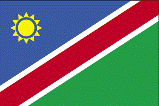|
Namibia
|

|
Capital: Windhoek
Population: 2,494,530
Brief History of Namibia:
Namibia was first inhabited by the San peoples. They were tribal people who hunted and gathered for a living. Around the 14th century the Bantu people migrated into the area.
The area wasn't explored by Europeans until the late 18th century, mostly because of the difficulties with exploring the Namib Desert. In 1878 Britain took control of the Walvis Bay area. Later, a German trader, Adolf Luderitz, claimed the rest of the coastal area for Germany. After a while, Germany and Britain negotiated a treaty and the entire area of Namibia became a German colony.
After World War I South Africa took control of the area. However, when many other countries were later granting independence to African nations, South Africa refused. The United Nations then revoked South Africa's mandate over Namibia. However, South Africa did not release control of the area until 1988. Namibia became an independent country in 1990.
The Geography of Namibia
Total Size: 825,418 square km
Size Comparison: slightly more than half the size of Alaska
Geographical Coordinates: 22 00 S, 17 00 E
World Region or Continent: Africa
General Terrain: mostly high plateau; Namib Desert along coast; Kalahari Desert in east
Geographical Low Point: Atlantic Ocean 0 m
Geographical High Point: Konigstein 2,606 m
Climate: desert; hot, dry; rainfall sparse and erratic
Major cities: WINDHOEK (capital) 342,000 (2009)
The People of Namibia
Type of Government: republic
Languages Spoken: English 7% (official), Afrikaans common language of most of the population and about 60% of the white population, German 32%, indigenous languages (Oshivambo, Herero, Nama)
Independence: 21 March 1990 (from South African mandate)
National Holiday: Independence Day, 21 March (1990)
Nationality: Namibian(s)
Religions: Christian 80% to 90% (Lutheran 50% at least), indigenous beliefs 10% to 20%
National Symbol:
National Anthem or Song: Namibia, Land of the Brave
Economy of Namibia
Major Industries: meatpacking, fish processing, dairy products; mining (diamonds, lead, zinc, tin, silver, tungsten, uranium, copper)
Agricultural Products: millet, sorghum, peanuts, grapes; livestock; fish
Natural Resources: diamonds, copper, uranium, gold, lead, tin, lithium, cadmium, zinc, salt, hydropower, fish
Major Exports: diamonds, copper, gold, zinc, lead, uranium; cattle, processed fish, karakul skins
Major Imports: foodstuffs; petroleum products and fuel, machinery and equipment, chemicals
Currency: Namibian dollar (NAD); South African rand (ZAR)
National GDP: $15,930,000,000
** Source for population (2012 est.) and GDP (2011 est.) is CIA World Factbook.
Back to Geography Home Page
